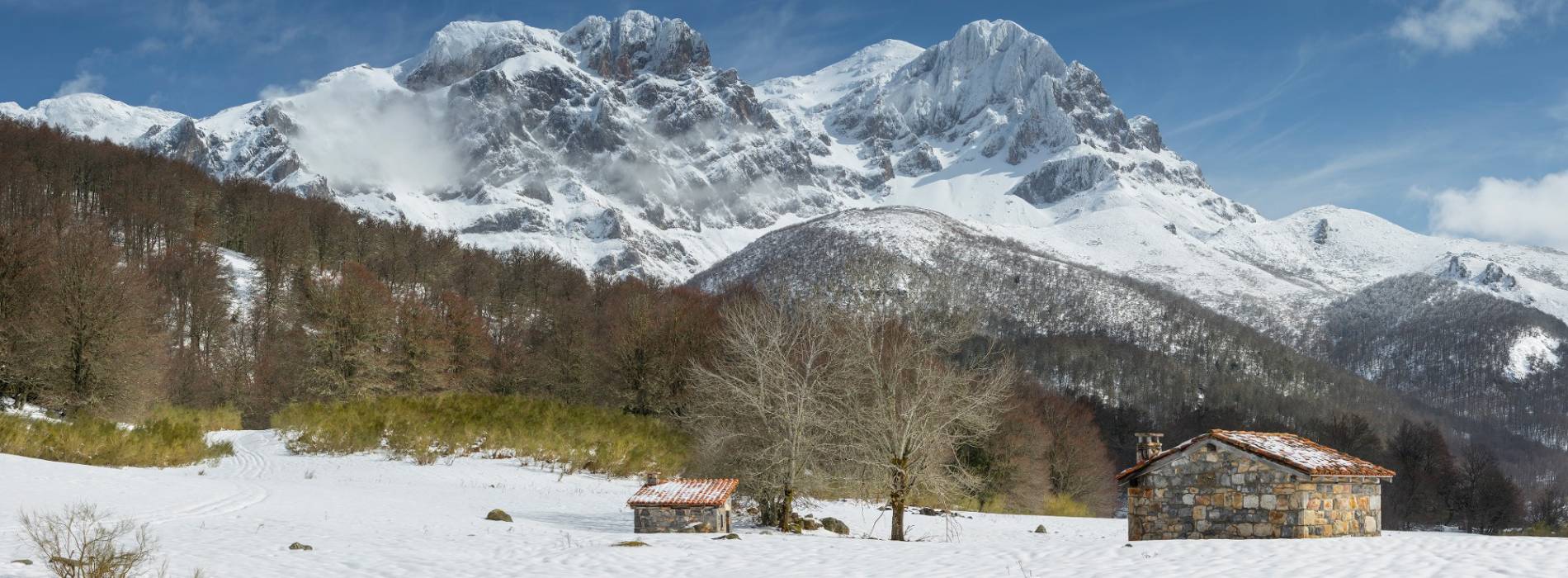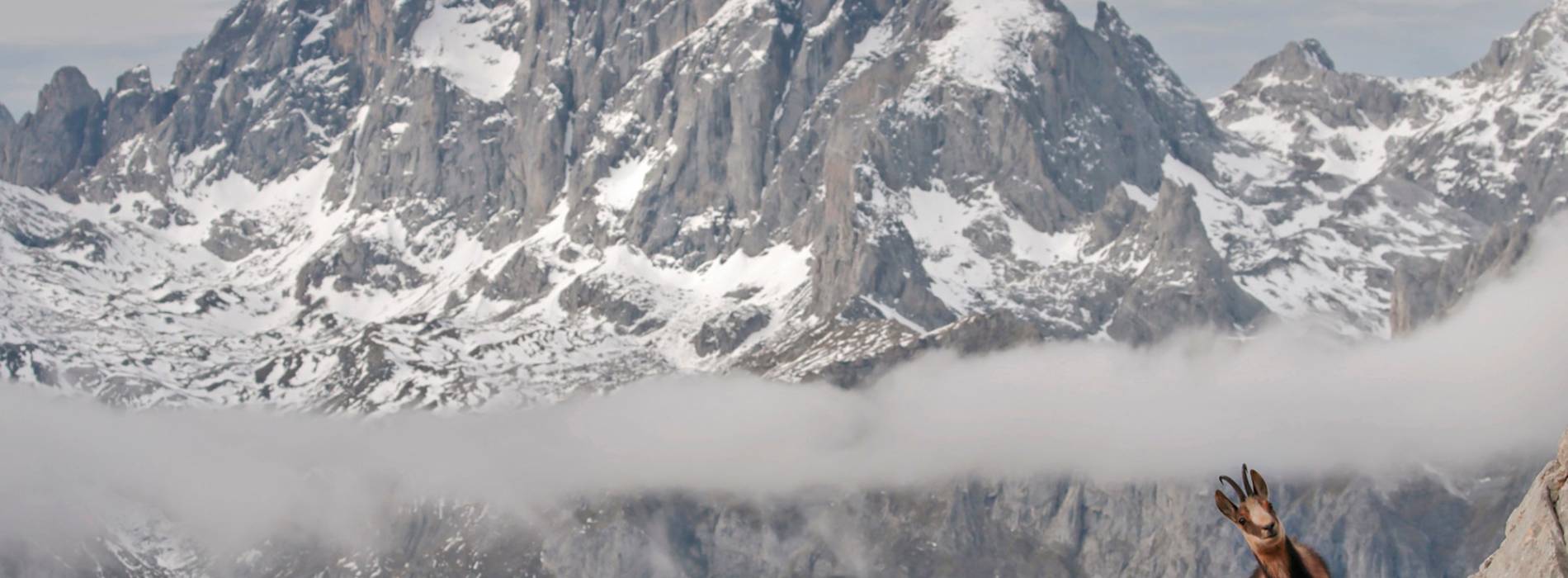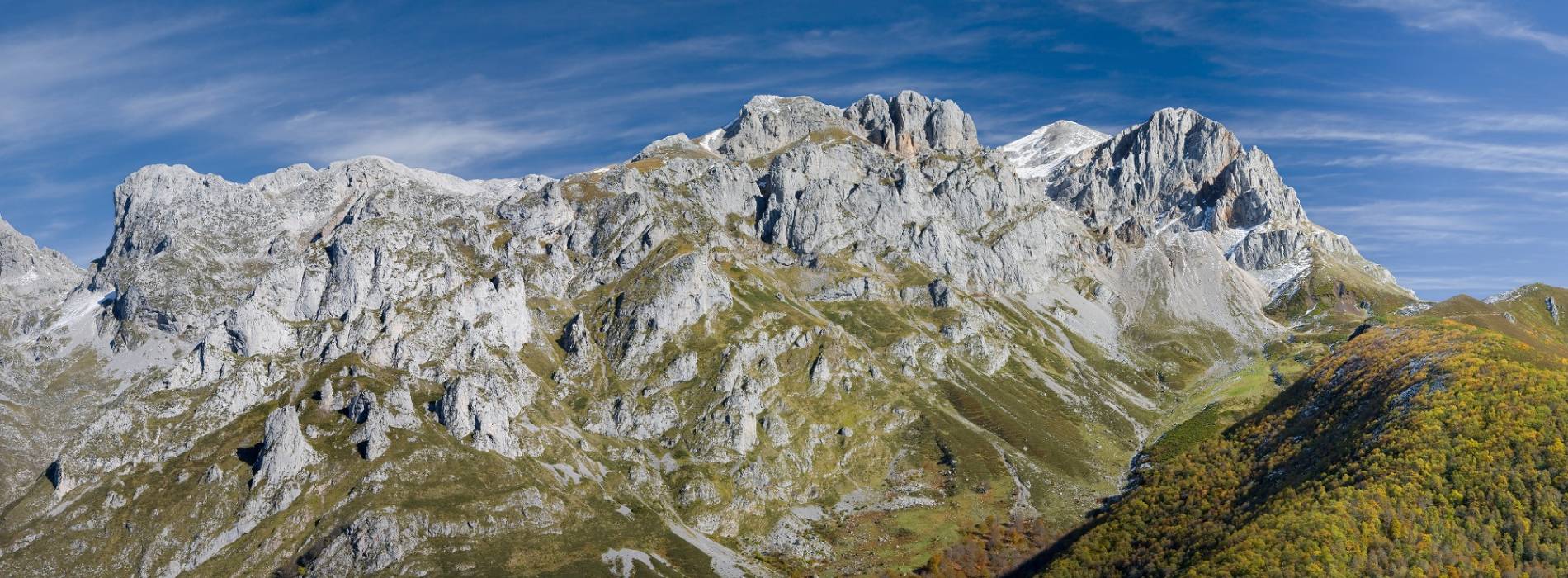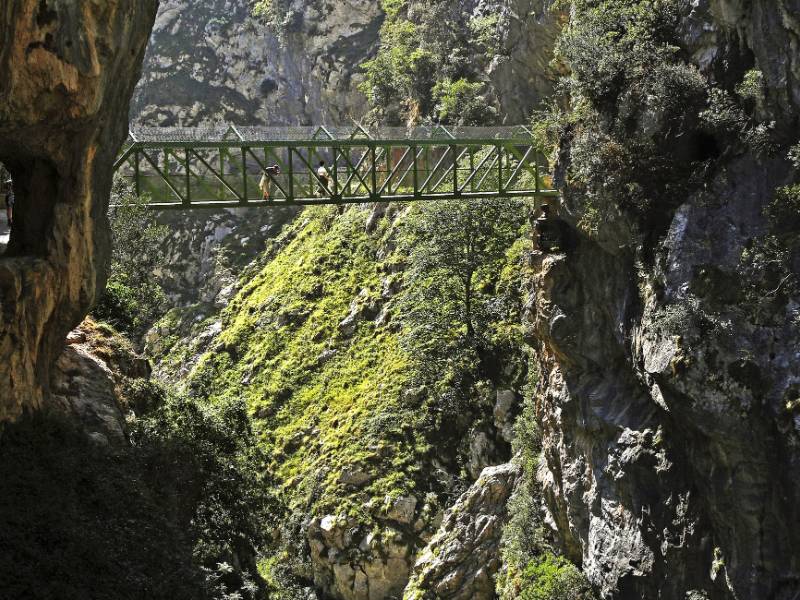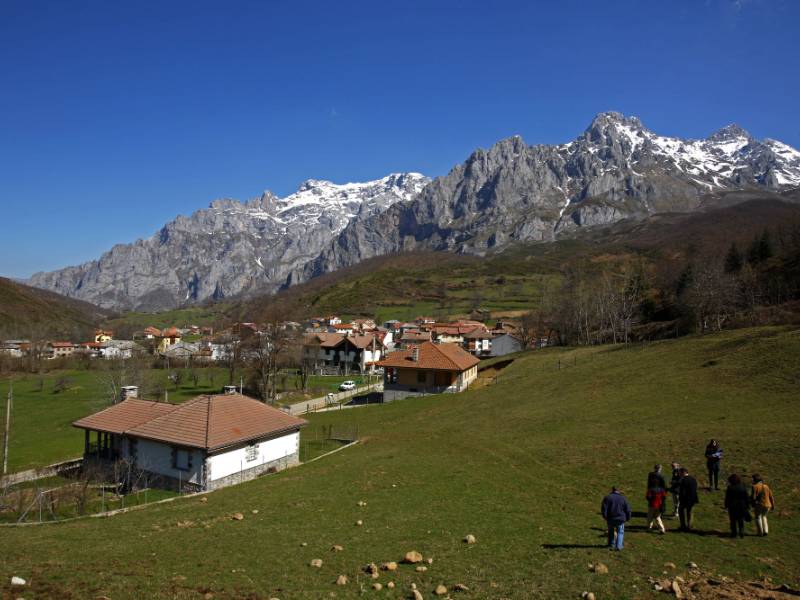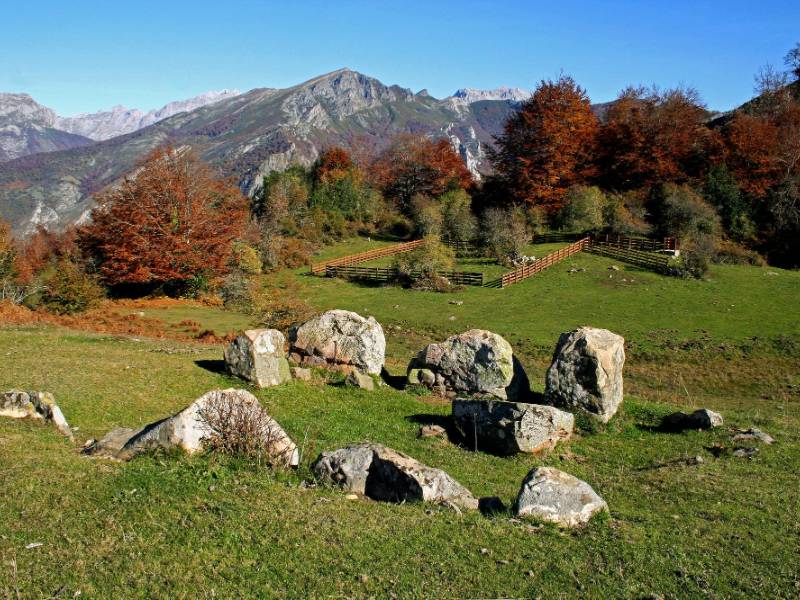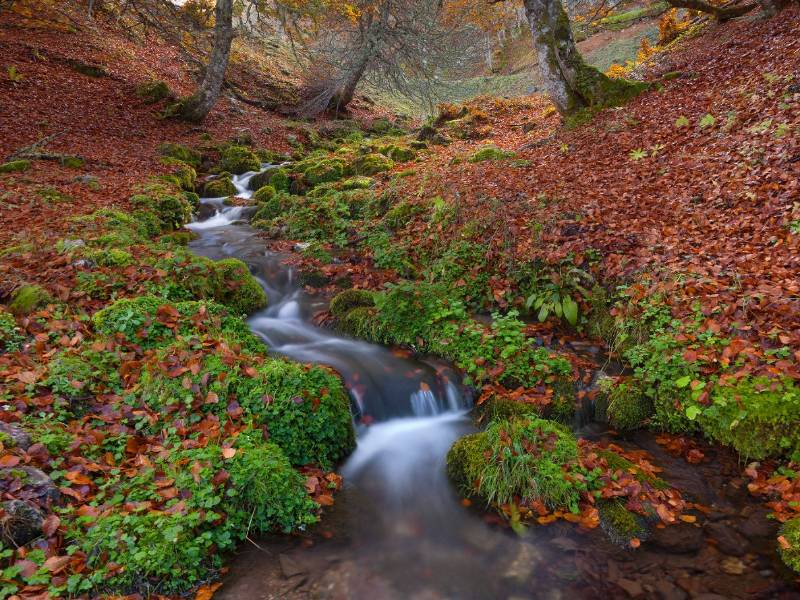Picos de Europa National Park
Occupying a territory that extends through Leon, Cantabria and the Principality of Asturias, the Picos de Europa National Park was the first national park created in Spain, with Oseja de Sajambre and Posada de Valdeón being the two municipalities of Castile and León that are part of it. from the park.
Discover the essence of the Picos de Europa National Park, where natural beauty and scenic grandeur combine in a unique landscape. The imposing mountains, which seem to touch the sky, are intertwined with serene valleys and gracefully meandering rivers. This corner of northern Spain invites you to explore its scars, markers of the Earth's history. The high peaks and deep chasms give shape to a majestic terrain that is home to a varied flora and fauna, from bearded vultures to lush beech forests.
Prepare your visit
Enviromental Areas
- wildlife
- The bear and capercaillie are the most representative species. Wolves, chamois, European badgers, otters, Bonelli's Eagle, Eurasian eagle-owl, Egyptian vulture and vautour percnoptère are some of its inhabitants.
- Relief
- A peculiar geological nature formed by a compact mass of limestone, broken and spectacular modeling. Its peculiar landscape is due to two types of erosion: glacier and karst.
- Vegetation
- The beech forms its main wooded mass. There are European holly, yew, chestnut, oak and birch also. Pinar de Lillo is a very interesting place but with a restricted access.
Get to know this natural space
Centro de Visitantes de Posada de Valdeón
Address
- Postal address Travesía del Soto. Posada de Valdeón. NaN. León
- Web
- Phones
- 987 740 549
- 987 740 587
La Fonseya Information Center
La Fonseya is located on the main road of the town of Oseja de Sajambre, a strategic point where the emblematic establishment of the same name was located. For many years this building was a bar, shop, restaurant, hostel and, above all, a meeting point...
On map
Address
- Postal address Carretera N-625, s/n. Oseja de Sajambre. NaN. León
- Phones696 137 464
Prepare your visit
Enjoy this natural space
On foot and by bike
- PR-PNPE 3 Cares RouteTo know more
The best-known trail of the Picos de Europa passes through the towns of: Posada de Valdeón, Cordiñanes, Caín and Poncebos. Interesting...
- Journey
- Linear
- Way
- On foot (5 h.)
- Length
- 21 kms.
- Ascent slope
- 160 m.
- Descent slope
- 899 m.
- Difficulty of the route
- Medium
- PR-PNPE 16 Collado JermosoTo know more
The shelter Collado Jermoso is located on a natural terrace on the western edge of Macizo Central. It has the best views of the valley...
- Journey
- Linear
- Way
- On foot (4 h.)
- Length
- 4.1 kms.
- Ascent slope
- 1,214 m.
- Difficulty of the route
- High
- L7 L7 - Sajambre popular architectureTo know more
Located in the Picos de Europa National Park. The tour highlights the traditional architecture of the area, among which the granary...
- Journey
- Circular
- Way
- On foot
- Length
- 8.5 kms.
- Ascent slope
- 600 m.
- Difficulty of the route
- Medium
- L8 L8 - Valdeón popular architectureTo know more
Located in the Picos de Europa National Park. The route begins in Posada de Valdeón and continues through Soto and Caldevilla, where,...
- Journey
- Linear
- Way
- On foot
- Length
- 8.2 kms.
- Ascent slope
- 324 m.
- Difficulty of the route
- Low
- PR-PNPE 15 Market PathTo know more
This route runs along what was known as the market paths, paths used by the residents of Valdeón to go to the fairs and livestock...
- Journey
- Linear
- Way
- On foot (9 h.)
- Length
- 26.4 kms.
- Ascent slope
- 831 m.
- Descent slope
- 692 m.
- Difficulty of the route
- Medium
- PR-PNPE 14 Monto Route (Valle de Prada)To know more
The route begins in Prada and gains altitude among agricultural meadows surrounded by trees and shrubs, home of several animal species.
- Journey
- Linear
- Way
- On foot (4.45 h.)
- Length
- 11.6 kms.
- Ascent slope
- 610 m.
- Difficulty of the route
- Medium
- GR-PNPE 201 Pathway of the Arcediano. Long Pathway Ponton-AmievaTo know more
This route was once one of the most important communication routes between Eastern Asturias and the plateau of Castilla y Leon, the...
- Journey
- Linear
- Way
- On foot (9.1 h.)
- Length
- 27.5 kms.
- Ascent slope
- 776 m.
- Descent slope
- 1,470 m.
- Difficulty of the route
- Medium
- GR-PNPE 201 Pathway of the Arcediano. Short Pathway Ponton-Soto de SajambreTo know more
It is one of the most important communication routes between the Plateau and the Eastern Asturias. The shortest path connects the...
- Journey
- Linear
- Way
- On foot (3.55 h.)
- Length
- 11 kms.
- Ascent slope
- 211 m.
- Descent slope
- 575 m.
- Difficulty of the route
- Medium
- PR-PNPE 15 Pathway of the little market. Long route. Posada de Valdeon-Fuente DeTo know more
It is so called because the inhabitants used the path to attend fairs and markets of livestock in the neighbouring region. The route...
- Journey
- Linear
- Way
- On foot (4.3 h.)
- Length
- 13.2 kms.
- Ascent slope
- 831 m.
- Descent slope
- 692 m.
- Difficulty of the route
- Medium
- PR-PNPE 15 Pathway of the little market. Short route. Santa Marina de Valdeon-Fuente DeTo know more
It is a variant of the journey, and allows reaching Fuente De in shorter time. The path was named for its role as route to the neighbouring...
- Journey
- Linear
- Way
- On foot (3.45 h.)
- Difficulty of the route
- Medium
- PR-PNPE 11 Route from Puerto de Panderrueda to Posada de ValdeonTo know more
This is a rich path in fauna and flora. Accompanied by beech woods we will cross many rivers and streams, as the Cares in its high...
- Journey
- Linear
- Way
- On foot (4 h.)
- Length
- 13.5 kms.
- Descent slope
- 511 m.
- Difficulty of the route
- Low
- PR-PNPE 10 Route villages of SajambreTo know more
The route shows the balance between traditional activities and respect for the environment, so, in this path we will discover the...
- Journey
- Circular
- Way
- On foot (3.3 h.)
- Length
- 10.2 kms.
- Ascent slope
- 405 m.
- Descent slope
- 405 m.
- Difficulty of the route
- Low
- GR-PNPE 9 Soto-Vegabaño RouteTo know more
The journey begins in Soto de Sajambre, town of traditional architecture, and approaches Vegabaño through a path that is known as...
- Journey
- Circular
- Way
- On foot (3.15 h.)
- Length
- 9.8 kms.
- Ascent slope
- 391 m.
- Difficulty of the route
- Low
- PR-PNPE 12 Vega de Llos RouteTo know more
The valley of Valdeon is one of the best preserved of the National Park. The route begins in Posada and approaches the peaks of the...
- Journey
- Circular
- Way
- On foot (4 h.)
- Length
- 13.5 kms.
- Descent slope
- 511 m.
- Difficulty of the route
- Low

